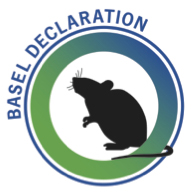Experiments in non-human primates
The participants at the symposium on the Basel Declaration at the end of November 2010 summarized the outcome of their discussions on the subject of experiments in non-human primates as follows:
1. Research in non-human primates is an essential part of biomedical progress in the 21st century. Research in non-human primates has led to the development of crucial medical treatments, such as vaccines against poliomyelitis and hepatitis (jaundice), as well as to improved drug safety thanks to indispensable contributions to the basic principles of physiology, immunology, infectious diseases, genetics, pharmacology, reproduction biology and neuroscience. We predict an increased need for research using non-human primates in the future, e.g. for personalized medicine and neurodegenerative diseases in an aging society. This continuing need is also reflected in the EU Directive of 2010 (2010 /63/EU) on animals used for scientific purposes, in which it is recognized that research in non-human primates will remain irreplaceable in the foreseeable future.
2. Biomedical research cannot be divided into “basic research” and “applied research”: it is a continuum that includes both basic studies on normal functions and their failure in diseases and also the development of treatments. This fundamental research is indispensable for biomedical progress. Any categorical restriction of research in non-human primates in basic research is shortsighted and not justified by any scientific evidence.
3. Researchers working with non-human primates are committed to the 3R principle on the replacement, reduction and refinement of animal experiments. Research in animals must satisfy the highest ethical standards. Non-human primates are only used when there are no alternatives. We are working constantly and intensively on refining experimental methods and keeping the number of non-human primates used to a minimum. A strong commitment to the 3Rs guarantees the best science and the best welfare of the animals.
4. We are committed to informing the public and providing objective information on research in non-human primates.

A model organism is a non-human species that is extensively studied to understand particular biological phenomena, with the expectation that discoveries made in the model organism will provide insight into the workings of other organisms. Model organisms are widely used to research human disease when human experimentation would be unfeasible or unethical. This strategy is made possible by the common descent of all living organisms, and the conservation of metabolic and developmental pathways and genetic material over the course of evolution.

Great ape personhood is a movement to extend personhood and some legal protections to the non-human members of the great ape family, Hominidae: chimpanzees, bonobos, gorillas, and orangutans.

Animal testing, also known as animal experimentation, animal research and in vivo testing, is the use of non-human animals in experiments that seek to control the variables that affect the behavior or biological system under study. This approach can be contrasted with field studies in which animals are observed in their natural environments or habitats. Experimental research with animals is usually conducted in universities, medical schools, pharmaceutical companies, defense establishments and commercial facilities that provide animal-testing services to industry. The focus of animal testing varies on a continuum from pure research, focusing on developing fundamental knowledge of an organism, to applied research, which may focus on answering some question of great practical importance, such as finding a cure for a disease. Examples of applied research include testing disease treatments, breeding, defense research and toxicology, including cosmetics testing. In education, animal testing is sometimes a component of biology or psychology courses. The practice is regulated to varying degrees in different countries.

The Great Ape Project (GAP), founded in 1993, is an international organization of primatologists, anthropologists, ethicists, and others who advocate a United Nations Declaration of the Rights of Great Apes that would confer basic legal rights on non-human great apes: chimpanzees, bonobos, gorillas, and orangutans.
Covance Inc. is a contract research organization (CRO) headquartered in Princeton, New Jersey, providing nonclinical, preclinical, clinical and commercialization services to pharmaceutical and biotechnology industries. The company is owned by LabCorp and employs more than 50,000 people in over 60 countries. According to its website, it is one of the largest companies of its kind in the world, with annual revenues of over $2 billion. It claims to provide the world's largest central laboratory network. It became a publicly traded company in 1997 after being spun off by Corning Incorporated in 1996. In 2018, the Covance parent company, Laboratory Corporation of America Holdings (LabCorp), was rated one of the best places to work for LGBTQ equality by the Human Rights Campaign. Covance has been subject to criticism from animal rights groups including People for the Ethical Treatment of Animals and the British Union for the Abolition of Vivisection for its animal testing procedures.
An animal model is a living, non-human, often genetic-engineered animal used during the research and investigation of human disease, for the purpose of better understanding the disease process without the added risk of harming an actual human. Although biological activity in an animal model does not ensure an effect in humans, many drugs, treatments and cures for human diseases are developed in part with the guidance of animal models. Animal models representing specific taxonomic groups in the research and study of developmental processes are also referred to as model organisms. There are three main types of animal models: Homologous, Isomorphic and Predictive. Homologous animals have the same causes, symptoms and treatment options as would humans who have the same disease. Isomorphic animals share the same symptoms and treatments, only. Predictive models are similar to a particular human disease in only a couple of aspects. However, these are useful in isolating and making predictions about mechanisms of a set of disease features.
A biomedical scientist is a scientist trained in biology, particularly in the context of medicine. These scientists work to gain knowledge on the main principles of how the human body works and to find new ways to cure or treat disease by developing advanced diagnostic tools or new therapeutic strategies. The research of biomedical scientists is referred to as biomedical research.
Animal models of stroke are procedures undertaken in animals intending to provoke pathophysiological states that are similar to those of human stroke to study basic processes or potential therapeutic interventions in this disease. Aim is the extension of the knowledge on and/or the improvement of medical treatment of human stroke.
Gillian Rose Langley is a British scientist and writer who specialises in alternatives to animal testing and animal rights. She was, from 1981 until 2009, the science director of the Dr Hadwen Trust for Humane Research, a medical research charity developing non-animal research techniques. She was an anti-vivisection member of the British government's Animal Procedures Committee for eight years, and has worked as a consultant on non-animal techniques for the European Commission, and for animal protection organizations in Europe and the United States. Between 2010 and 2016 she was a consultant for Humane Society International.

The Foundation for Biomedical Research (FBR) is an American non profit organization, 501(c)(3), located in Washington, DC. Established in 1981, the organization is dedicated to informing the news media, teachers, and other groups about the need for lab animals in medical and scientific research. The organization, together with its partner, the National Association for Biomedical Research (NABR), argues that promoting animal research leads to improved health for both humans and animals.

Experiments involving non-human primates (NHPs) include toxicity testing for medical and non-medical substances; studies of infectious disease, such as HIV and hepatitis; neurological studies; behavior and cognition; reproduction; genetics; and xenotransplantation. Around 65,000 NHPs are used every year in the United States, and around 7,000 across the European Union. Most are purpose-bred, while some are caught in the wild.

Alternatives to animal testing are the development and implementation of test methods that avoid the use of live animals.

Animal testing regulations are laws or guidelines that permit and control the use of non-human animals for scientific experimentation. They vary greatly around the world, but most governments aim to control the number of times individual animals may be used; the overall numbers used; and the degree of pain that may be inflicted without anesthetic.

Tatsuji Nomura M.D., Ph.D. was a pioneer in the development of laboratory animals with the aim of assuring reproducibility of experimental results in medical research. He was Director of the Central Institute for Experimental Animals (CIEA), Japan

Understanding Animal Research (UAR) is a British membership organisation formed in late 2008 through the merger of the Research Defence Society and the Coalition for Medical Progress. Its main aims are to "explain why animals are used in medical and scientific research. We aim to achieve a broad understanding of the humane use of animals in medical, veterinary, scientific and environmental research in the UK".

The National Association for Biomedical Research (NABR) is an American non profit organization, 501(c)(6), located in Washington, DC. NABR was formed in 1985 when the Association of Biomedical Research merged with the National Society for Medical Research The NABR advocates for the continued use of animals in biomedical research albeit in as humane a manner as possible.
The European Partnership for Alternative Approaches to Animal Testing (EPAA) promotes the application of Russell and Burch’s 3Rs principles in meeting regulatory requirements for products such as pharmaceuticals, chemicals, soaps, detergents and cosmetics. The EPAA covers research and development, as well as the use of 3Rs approaches in regulatory compliance and communication and dissemination.

The Three Rs (3Rs) in relation to science are guiding principles for more ethical use of animals in testing. They were first described by W. M. S. Russell and R. L. Burch in 1959. The 3Rs are:
- Replacement:methods which avoid or replace the use of animals in research
- Reduction: use of methods that enable researchers to obtain comparable levels of information from fewer animals, or to obtain more information from the same number of animals.
- Refinement: use of methods that alleviate or minimize potential pain, suffering or distress, and enhance animal welfare for the animals used.

EU Directive 2010/63/EU is the European Union (EU) legislation "on the protection of animals used for scientific purposes" and is one of the most stringent ethical and welfare standards worldwide.
International Primate Day, September 1, is an annual educational observance event organized since 2005 largely by British-based Animal Defenders International (ADI) and supported annually by various primate-oriented advocacy organizations, speaks for all higher and lower primates, typically endorsing humane agendas where primates are at risk, as in research institutions or species endangerment in precarious environmental situations.







